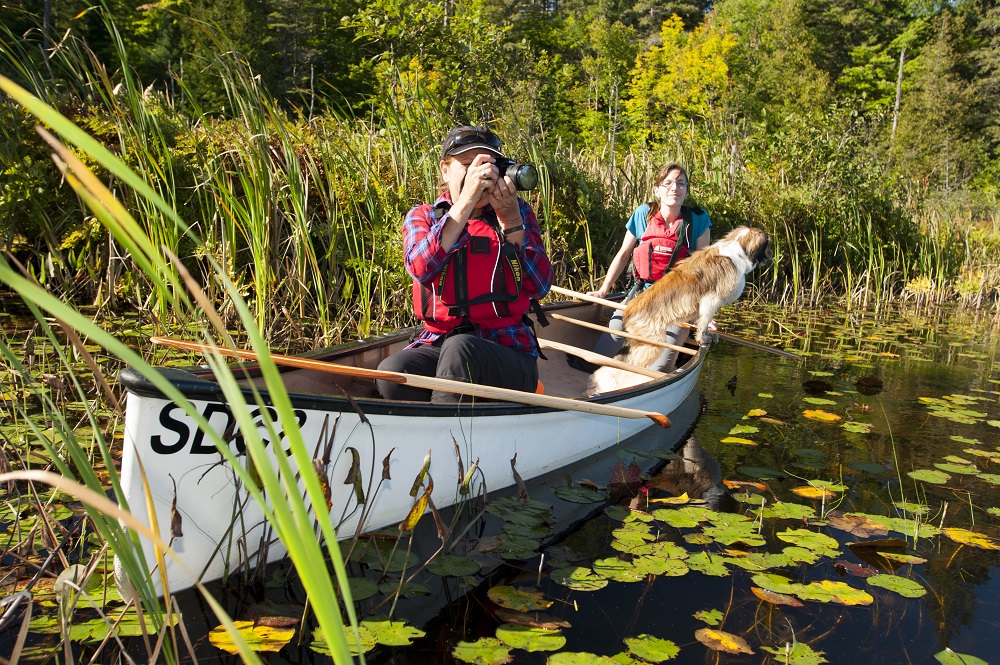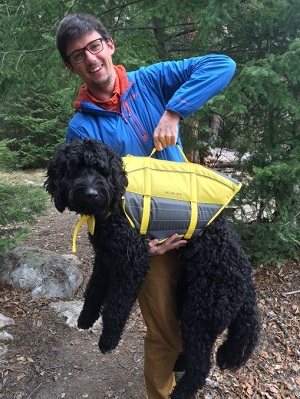Today’s post comes from Jill Legault, Information Specialist at Quetico Provincial Park.
Summertime means puppy playtime!
Dogs love the opportunity to be outside as much as you do. A little planning means every family member is happy and safe in the backcountry.
Where and when to start
We started our puppy off by introducing her to a lake edge well before she got in a canoe. It’s important to know how your dog will be around water and if they are comfortable swimming.

Our first time in a canoe, we opted for a short day trip from Nym Lake to Batchewaung Lake on a sunny calm day. We had taken her to Nym Lake’s shoreline several times before, so it was familiar and she wasn’t stressed.
Our dog is not one to get motion sick, but that may be something to consider. If your dog gets sick in the car, a windy day in a canoe may be a challenge too.
Canoeing with your pup
Be sure your dog listens to “sit,” “lie down,” and “stay.” These commands will be crucial when travelling by canoe.

Getting into the canoe can be a challenge. We started off on some sandy gradual landings or ones with easy access, and worked up to rock-hopping.
Getting out of the canoe can also be difficult. It is important that your dog will “stay” until you land, even if they’re excited to jump in the water, or meet a fellow camper.
Allow them plenty of time to get comfortable settling in the canoe. Our dog loves sleeping with her back against something, but we also need her weight to be centred. We’ve worked a lot on getting her to lie down in the middle of the canoe.

For many dogs, expecting them to sit still for an hour is too much to ask. We’ve brought a bone for large lake crossings where she gets bored of sleeping.

If canoe camping doesn’t work out the first time, don’t give up! Try some low-key day trips from a campground, or base-camp in the interior for a few nights. With patience and time, you’ll be rewarded with a well-seasoned travel buddy.
Dog behaviour
It’s important to keep your dog under control in the backcountry. Loose dogs can disturb and harass wildlife — a big no-no. However, you should NEVER tie a leashed dog to a canoe — this is a drowning risk.
The start and end of the trip can be very stressful for your canine friend. Pay particular attention to your dog’s comfort level at these moments, and times of transition.

My dad still bears the scars on his knees from being asked as a (scrawny) kid to hold someone’s dog while they went to set their canoe in the water.
As he recalls, the “giant” boxer thought it was being left behind, and, with my dad unable to let go, dragged him down the cement boat launch.
Take your time during these transitions. Interior parking lots can get busy and loud, with lots of trailers backing up and large summer camp groups.
Doggy First-Aid
Before heading out, talk to your local veterinarian. We talked with ours about what to carry with us, medication and dosages in emergencies (allergic reactions, vomiting, pain, fever, etc.), and what is appropriate for our area.
For example, if there is Lyme Disease in your area, there are several preventative measures to choose from, including packing a tick remover.

Some things to consider adding to your usual human First Aid kit include self-adhesive vet wrap, baby-sized socks for cut or split paws, and your vet’s phone number.
Pack needle-nose pliers and side cutters if you’re going fishing, just in case your dog gets hooked.
Dogs and fishing
What isn’t fun and tantalizing about a dangling bright lure?
The backcountry is no place to be learning hard lessons. If you plan on fishing, be sure to take your dog fishing before heading off into the wilderness.

Keep all your tackle in a closed box in the canoe. In many parks, such as Quetico, barbless hooks are required. Regardless of where you’re fishing, until your dog is a reliable fishing companion, it’s a good preventative measure to pinch down barbs so hooks are easier to slide out.
If casting from shore, your dog needs to know when it needs to “stay.” This is for its own safety (a leash tug during a cast could end bad for you or your pup), but you also don’t want them scaring off your dinner! Never trust others to watch out for your dog while they cast.
Finally, while filleting a fish, make sure your dog stays well away. It’s a bad idea to let your dog eat raw fish due to bacteria that can cause food poisoning. Some fish also contain parasites that can be fatal to your pup.
Dog gear
Using a canine Personal Flotation Device all depends on your dog’s comfort level, ability to swim, and where you are going.
At the end of the day, you want your dog to be safe. I recommend a puppy PFD, particularly for big lakes and anything with running water.

Even a fabulous swimmer can panic if you suddenly flip in the middle of a lake.
Our dog also looks like a bear, and we’ve had fellow portagers thank us for the PFD, so they could quickly identify her.
Speaking of bears, we attach a bear bell to her collar. Whether at a campsite or carrying over a portage, we don’t want our pup to startle a bear.
Our dog is black so a glow light at night has been really helpful when keeping track of her.
Our vet recommended that we carried all the camping equipment for her first year. However, a fit and fully-grown dog can carry up to one third of its weight in gear. They can help you with portaging, so long as the saddlebag fits properly.

Don’t forget!
You need to clean up after your furry friend. There is nothing worse than setting down your tent in dog poop someone else has left behind. Be a responsible pet owner.
